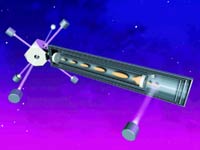Time–Who
Needs It?
Time
has become a very valuable commodity. In our everyday lives we never
seem to have enough of it. In scientific and technical fields, such
as navigation, telecommunications, and electrical power distribution,
time is so valuable it must be measured extremely precisely.
But,
how do you know the time is right? That’s where the National
Institute of Standards and Technology, better known as NIST, comes
in. As a non-regulatory agency of the U.S. Department of Commerce, NIST develops and promotes measurement,
standards, and technology to enhance productivity, facilitate trade,
and improve the quality of life. Part of NIST’s mission is
to work with other nations to define and disseminate basic standards
like length, mass, and the second.
In
its laboratories in Boulder, Colo., NIST maintains the world’s
most accurate clock. The NIST F1 Clock will neither gain nor lose
a second in 30 million years. NIST transmits its most accurate time
to the International Bureau of Weights and Measures in Paris, which
accumulates the best time data from many other nations, averages
them, and distributes that average as Universal Coordinated Time,
or UTC. It is this official time that is used worldwide.
You
can find the official time Web site at www.time.gov.
By clicking on your time zone, you will get the time of day to within
0.2 second. If you don’t mind spending a few cents for a long
distance call, you also can get the official time by dialing (303)
499-7111. You will hear a series of clicks and then a voice announcement
on the minute. It will be given in UTC so you will have to adjust
for your time zone.
If
you have a shortwave radio, you can get continuous time broadcasts
from NIST’s shortwave radio stations—WWV in Fort Collins,
Colo., or WWVH in Hawaii. Most recently, NIST has boosted the power
on an ultralow frequency radio station—WWVB—in Fort Collins
that broadcasts throughout the lower 48 states. Some clock and watch
manufacturers have placed tiny receivers in their products that
can pull in the WWVB signal and automatically reset your timepiece
to UTC.
To
learn more about NIST time services, the history of timekeeping,
and ongoing research to make even more precise clocks, go to www.boulder.nist.gov/timefreq/index.html.
Go
back to Fact Sheet page
Date
created: 09/13/02
Contact:
inquiries@nist.gov
|

NIST Network
Time Service

NIST F-1
Fountain Clock

Primary Atomic
Reference Clock
in Space (PARCS)—scheduled to fly on the International Space
Station in 2005.
|
|

